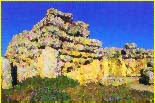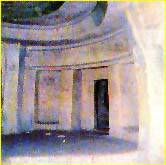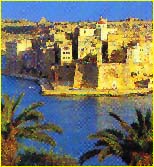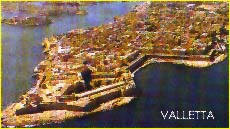| |
In spite of its small size, Malta's strategic location at the cross-roads of the Mediterranean has meant that, over the centuries, the island has played a very important role in the region, right from the early days of civilisation to the present times. All periods of Malta's history make fascinating reading. The particular periods that we are going to cover are:
|
|
The Neolithic period
Until recently, the Egyptian pyramids were thought to be the oldest architectural monuments in existence. Recent archaelogical research however, has shown that the earliest Neolithic temples on Malta are about 1000 years older than the famous pyramids of Giza. Huge rocks, several tons in weight were used in the construction of these temples. How these enormous loads were moved, or even lifted, 5000 or 6000 years ago remains a mystery.
 The earliest temples, such as the one at Ggantija on Gozo, were built by the piling of huge rocks on top of each other. They did not have any carving or decoration. Later temples, such as the one at Hagar Qim, in Malta were made of huge stones fitting very closely together and ornately decorated. Carving was done with only very primitive flint and obsidian tools. No archaeological remains made of metal from this period have been discovered on Malta. One theory is that prehistoric people did not use metal because they foresaw, in its use, their own future destruction. The earliest temples, such as the one at Ggantija on Gozo, were built by the piling of huge rocks on top of each other. They did not have any carving or decoration. Later temples, such as the one at Hagar Qim, in Malta were made of huge stones fitting very closely together and ornately decorated. Carving was done with only very primitive flint and obsidian tools. No archaeological remains made of metal from this period have been discovered on Malta. One theory is that prehistoric people did not use metal because they foresaw, in its use, their own future destruction.
 The subterranean burial place at Malta's Hal Saflieni, the so-called Hypogeum, is an even more astonishing relic and its accidental discovery in 1902 caused quite a sensation in world archaelogical circles. The temple must have been literally carved into the rocks over hundreds of years with simple tools made from flint and obsidian. Starting at ground level the Hypogeum descends several storeys below ground and covers an area of more than 500 square metres. The Hypogeum was certainly a place of worship and burial - the bones of over 7000 people have been found - and could also have been used as a place for the training of priestesses. A number of relics support this hypothesis. The subterranean burial place at Malta's Hal Saflieni, the so-called Hypogeum, is an even more astonishing relic and its accidental discovery in 1902 caused quite a sensation in world archaelogical circles. The temple must have been literally carved into the rocks over hundreds of years with simple tools made from flint and obsidian. Starting at ground level the Hypogeum descends several storeys below ground and covers an area of more than 500 square metres. The Hypogeum was certainly a place of worship and burial - the bones of over 7000 people have been found - and could also have been used as a place for the training of priestesses. A number of relics support this hypothesis.
All trace of the mysterious people who built the Hypogeum disappeared suddenly around 2000 BC - at the height of their culture. How this peaceful people disappeared we will never know. It remains pure speculation as to whether conquerors with modern metal weapons wiped out this anarmed, unfortified people, or whether a sudden epidemic destroyed all human life on Malta for centuries. Equally strange and mysterious are the cart ruts found on many of the rocky ridges in Malta. The most popular theory is that these were made by primitive slide-carts used before the invention of the wheel.
The Knights
Many hundreds of years after the Neolithic period and precisely in 1530, the Knights of the Order of St. John brought about another epoch of great cultural significance to the island. The history of the Knights of St. John begins in the middle of the eleventh century in the Holy Land. The Order's original duties were to care for sick and wounded Christian pilgrims to the Holy Land and to help the poor. But very soon their duties expanded; the fight against the 'infidels' became of equal or even greater importance. The Knights became 'Soldiers of Christ'. They acquired and maintained huge estates and castles in the Holy Land and finally owned a large fleet.
 With the loss of Acre of the Moslems in 1291, however, the fate of the Knights was sealed. They withdrew to Rhodes and acted as a shield against the Turks for two centuries until 1522 when Suleiman the Magnificent ousted the Knights from Rhodes. They now needed a new homeland and, in 1530, moved to Malta to which they were given tenure by Emperor Charles V. With the loss of Acre of the Moslems in 1291, however, the fate of the Knights was sealed. They withdrew to Rhodes and acted as a shield against the Turks for two centuries until 1522 when Suleiman the Magnificent ousted the Knights from Rhodes. They now needed a new homeland and, in 1530, moved to Malta to which they were given tenure by Emperor Charles V.
The Knights quickly improved trade and commerce on the islands, built new hospitals and, most important, erected new strong fortifications. But Suleiman wanted to destroy the Order completely and use Malta as a base from which to attack Southern Europe. In 1565 he set out with a strong fleet to drive the Knights out of Malta.
The siege which his navy laid on Malta , referred to by the Maltese as the Great Siege of 1565, lasted four months with fighting of almost unimaginable ferocity. Although heavily outnumbered, the Knights stood firm and finally won, assisted by the Maltese people and by last minute reinforcements from Sicily. The Turks had no alternative but to beat retreat leaving behind them an impressive number of dead amongst whom the feared corsair Dragut.
The Knights of St. John had successfully protected Southern Europe and Christendom.
 After their victory against the Turks, the Knights turned enthusiastically to the further development of Malta and Gozo. A golden era in culture, architecture and the arts followed. Many of Malta's most attractive buildings were built during this period. A new fortress city, Valletta, was vuilt and named in honour of the Grand Master Jean Parisot de la Valette under whose inspired guidance the knights and the Maltese had defined the Turkish onslaught. Valletta is one of the earliest examples of a planned city built on the grid system. The Knights of St. John, coming as they did from the richest families in Europe, could afford to hire the best talent available and the buildings of Valletta, its fortifications and the art treasures in its museums and churches are the work of the best European engineers and artists of the time. It was the magnificence of its palaces and other treasures that led Sir Walter Scott to describe Valletta as "The city built by gentlemen for gentlemen" After their victory against the Turks, the Knights turned enthusiastically to the further development of Malta and Gozo. A golden era in culture, architecture and the arts followed. Many of Malta's most attractive buildings were built during this period. A new fortress city, Valletta, was vuilt and named in honour of the Grand Master Jean Parisot de la Valette under whose inspired guidance the knights and the Maltese had defined the Turkish onslaught. Valletta is one of the earliest examples of a planned city built on the grid system. The Knights of St. John, coming as they did from the richest families in Europe, could afford to hire the best talent available and the buildings of Valletta, its fortifications and the art treasures in its museums and churches are the work of the best European engineers and artists of the time. It was the magnificence of its palaces and other treasures that led Sir Walter Scott to describe Valletta as "The city built by gentlemen for gentlemen"
The French and the English
In 1789 Napoleon, on his way to Egypt, dropped anchor outside Grand Harbour on the pretext that his expedition needed fresh water supplies. He found an Order which had lost its morale. Not surprisingly, the French Navy did not have to fire a single shot to secure Malta's surrender from the Knights. However, French rule in Malta was short-lived. By 1800 the Maltese, with help of Lord Nelson, managed to drive the French garisson out of Malta and sought the protection of the British throne. That was to mark the beginning of a close association between Malta and Britain over 160 years. Malta became independent in 1964 and adopted a Republican Constitution in 1974.
|
If you are looking for a custom decal or a decal that is out of production
or hard to find contact us and can produce this for you.
< |











 The earliest temples, such as the one at Ggantija on Gozo, were built by the piling of huge rocks on top of each other. They did not have any carving or decoration. Later temples, such as the one at Hagar Qim, in Malta were made of huge stones fitting very closely together and ornately decorated. Carving was done with only very primitive flint and obsidian tools. No archaeological remains made of metal from this period have been discovered on Malta. One theory is that prehistoric people did not use metal because they foresaw, in its use, their own future destruction.
The earliest temples, such as the one at Ggantija on Gozo, were built by the piling of huge rocks on top of each other. They did not have any carving or decoration. Later temples, such as the one at Hagar Qim, in Malta were made of huge stones fitting very closely together and ornately decorated. Carving was done with only very primitive flint and obsidian tools. No archaeological remains made of metal from this period have been discovered on Malta. One theory is that prehistoric people did not use metal because they foresaw, in its use, their own future destruction. The subterranean burial place at Malta's Hal Saflieni, the so-called Hypogeum, is an even more astonishing relic and its accidental discovery in 1902 caused quite a sensation in world archaelogical circles. The temple must have been literally carved into the rocks over hundreds of years with simple tools made from flint and obsidian. Starting at ground level the Hypogeum descends several storeys below ground and covers an area of more than 500 square metres. The Hypogeum was certainly a place of worship and burial - the bones of over 7000 people have been found - and could also have been used as a place for the training of priestesses. A number of relics support this hypothesis.
The subterranean burial place at Malta's Hal Saflieni, the so-called Hypogeum, is an even more astonishing relic and its accidental discovery in 1902 caused quite a sensation in world archaelogical circles. The temple must have been literally carved into the rocks over hundreds of years with simple tools made from flint and obsidian. Starting at ground level the Hypogeum descends several storeys below ground and covers an area of more than 500 square metres. The Hypogeum was certainly a place of worship and burial - the bones of over 7000 people have been found - and could also have been used as a place for the training of priestesses. A number of relics support this hypothesis. With the loss of Acre of the Moslems in 1291, however, the fate of the Knights was sealed. They withdrew to Rhodes and acted as a shield against the Turks for two centuries until 1522 when Suleiman the Magnificent ousted the Knights from Rhodes. They now needed a new homeland and, in 1530, moved to Malta to which they were given tenure by Emperor Charles V.
With the loss of Acre of the Moslems in 1291, however, the fate of the Knights was sealed. They withdrew to Rhodes and acted as a shield against the Turks for two centuries until 1522 when Suleiman the Magnificent ousted the Knights from Rhodes. They now needed a new homeland and, in 1530, moved to Malta to which they were given tenure by Emperor Charles V. After their victory against the Turks, the Knights turned enthusiastically to the further development of Malta and Gozo. A golden era in culture, architecture and the arts followed. Many of Malta's most attractive buildings were built during this period. A new fortress city, Valletta, was vuilt and named in honour of the Grand Master Jean Parisot de la Valette under whose inspired guidance the knights and the Maltese had defined the Turkish onslaught. Valletta is one of the earliest examples of a planned city built on the grid system. The Knights of St. John, coming as they did from the richest families in Europe, could afford to hire the best talent available and the buildings of Valletta, its fortifications and the art treasures in its museums and churches are the work of the best European engineers and artists of the time. It was the magnificence of its palaces and other treasures that led Sir Walter Scott to describe Valletta as "The city built by gentlemen for gentlemen"
After their victory against the Turks, the Knights turned enthusiastically to the further development of Malta and Gozo. A golden era in culture, architecture and the arts followed. Many of Malta's most attractive buildings were built during this period. A new fortress city, Valletta, was vuilt and named in honour of the Grand Master Jean Parisot de la Valette under whose inspired guidance the knights and the Maltese had defined the Turkish onslaught. Valletta is one of the earliest examples of a planned city built on the grid system. The Knights of St. John, coming as they did from the richest families in Europe, could afford to hire the best talent available and the buildings of Valletta, its fortifications and the art treasures in its museums and churches are the work of the best European engineers and artists of the time. It was the magnificence of its palaces and other treasures that led Sir Walter Scott to describe Valletta as "The city built by gentlemen for gentlemen"